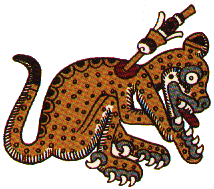
Return to: main Nahuatl page, main web page.
Table of Contents

For yet more information, contact:
Return to: top, main Nahuatl page, main web page.
Classical Nahuatl was once the dominant language of central Mexico. Committed to Roman letters shortly after the Spanish arrival, Classical Nahuatl boasts a wealth of texts of late Aztec and early Colonial life in Mexico, from deeds and wills to poems and letters, from the Tale of Quetzalcoatl to the account of the apparition of the Virgin of Guadalupe.
In general at most sessions we swot our way through a bit of Nahuatl text, translation in hand, trying to see how the Nahuatl can possibly mean what the translators interpret it as meaning, and in theory gradually picking up a sense of how Nahuatl works in its own terms. Over the course of time we use a wide range of texts differing in difficulty, subject matter, and style. (At least will do so if we live long enough --Nahuatl doesn't lend itself to rushing things.)
Despite several years of my fooling with it, none of us actually knows much (read: any) Nahuatl (which is fascinating but remarkably counterintuitive), so we are essentially rudderless and all bowling on the same forty yard line. But the spirit of Quetzalcóatl will watch over us. (Or Nazahualcóyotl. Or Aunt Minnie. Or somebody.)
If you know of anybody else interested in Classical Nahuatl (and/or bad at bowling), by all means spread the word.
Return to: top, main Nahuatl page, main web page.
The nifty graphic at the beginning of this page (repeated here) shows an ocelot that has been spoken to in Nahuatl. The language is represented by the artist as an àtlatl dart straight into the heart of the animal.

According to some scholars, Nahuatl often proved fatal to New World game animals, as it did also to the Aztecs' (many) enemies. As one famous Tarascan warrior put it: "Blyaaaaaaaaaahhhh! I am undone!"
Already in 1571, Fr. Bernardino Sebastiano de Gallo y Toro estimated that Aztec success in war had owed far less to the àtlatl than it did to preterite agentive deverbative noun forms, although some believe that it was past quotidian verbs that were eventually to prove most debilitating to the unwary.
If you learn Nahuatl, you will of course dazzle your friends, but you will also be able to disconcert your enemies and strike down ocelots with a single applicative.
(The picture itself is from an old Nahuatl codex called "War & Hunting Secrets Never to Tell the Goymê.")
Return to: top, main Nahuatl page, main web page.